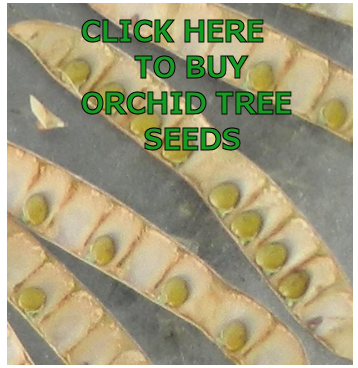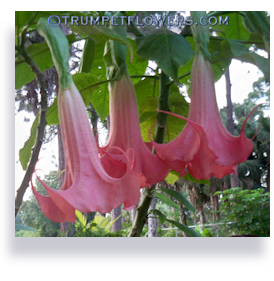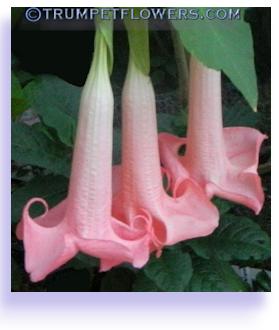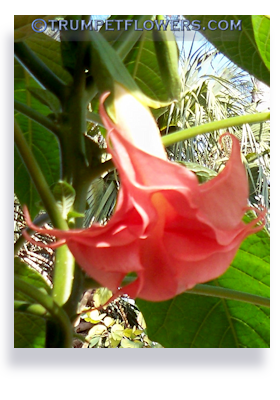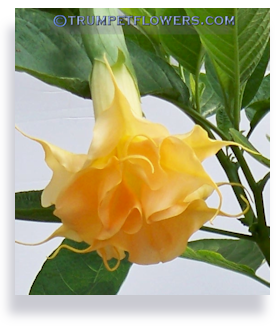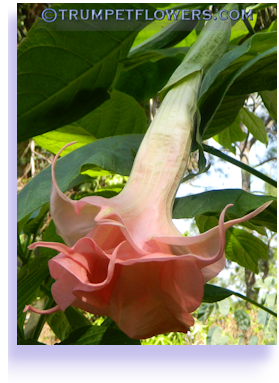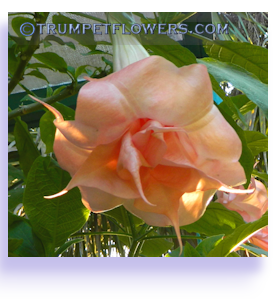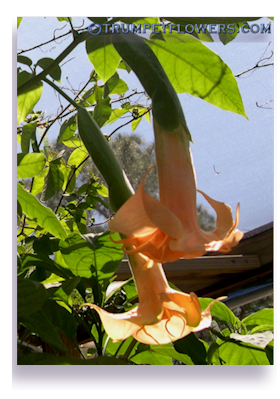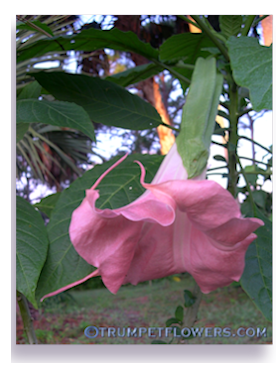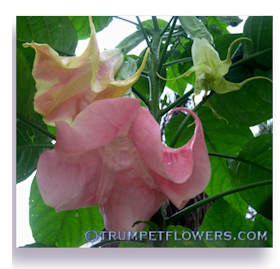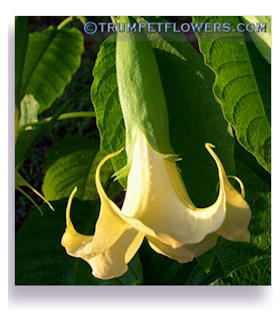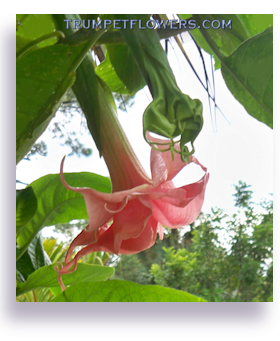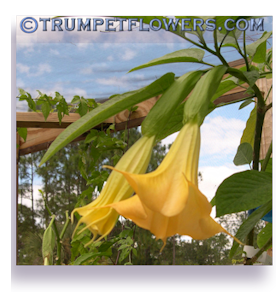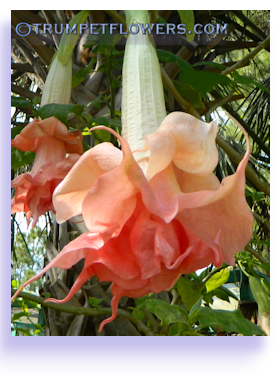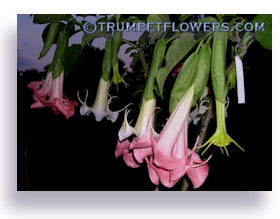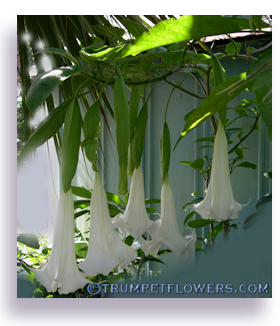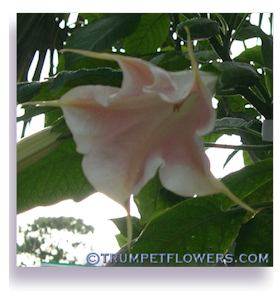Growing Orchid
Trees
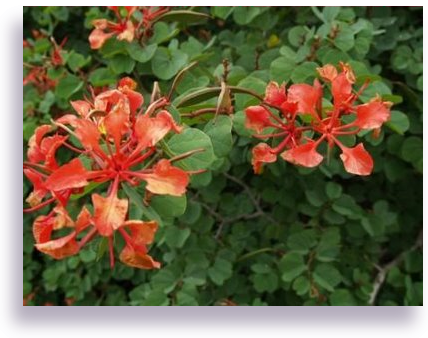 Bauhinia, or Orchid trees, as they are commonly called, are medium to large ornamental flowering trees from subtropical and tropical regions of the world. Many species do very well here in southern Florida.
Bauhinia, or Orchid trees, as they are commonly called, are medium to large ornamental flowering trees from subtropical and tropical regions of the world. Many species do very well here in southern Florida.
Orchid trees are easy to maintain, and make an excellent patio container plant. They are also lovely specimen trees, if you prune them their first few years so the canopy is properly shaped. Many bauhinia will flower within a year from seed, and most within 2 years.
Flowers of bauhinia do resemble those of orchids, and are the main attraction. Colors of white, purple, pink, lavendar, red, orange, and yellow are all found within the bauhinia range, and color depends on species. Some are rare, but most are attainable.
Bauhinia have several advantages for the gardener or landscaper. They are a medium (sometimes small) sized tree, so controlling their size is easy to do. They even make great potential bonsai plants, and do have a bit of an Oriental flair to them, at least in tree shape. A beautiful canopy that can be controlled to within 20 feet in height is always a plus.
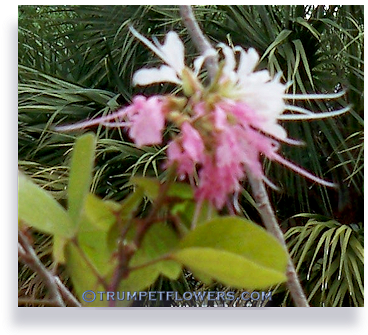 Orchid trees are in the fabaceae family, and poccess pods as a way of reproduction. Most pods of bauhinia species split open and 'toss' the seeds out, like the purple bauhinia. Because the purple bauhinia does spit the seeds, (so does the white acuminata) it is sometimes not welcomed by those gardeners who try to control non∼native treese. I prefer the flower of the white and the red species, and even though b. acuminata does throw the seeds, regular mowing does the trick on any tiny seedlings that may sprout at the adult tree's feet.
Orchid trees are in the fabaceae family, and poccess pods as a way of reproduction. Most pods of bauhinia species split open and 'toss' the seeds out, like the purple bauhinia. Because the purple bauhinia does spit the seeds, (so does the white acuminata) it is sometimes not welcomed by those gardeners who try to control non∼native treese. I prefer the flower of the white and the red species, and even though b. acuminata does throw the seeds, regular mowing does the trick on any tiny seedlings that may sprout at the adult tree's feet.
Grow Bauhinia from Seed
Bauhinia seeds are usually flat, hard and roundish to oblong. If you have access to fresh seedpods, harvest them when the pod turns brown and becomes almost brittle. Most bauhinia seed pods will open themselves when ripe, tossing the seeds to the ground. There you must quickly look for them, before they begin to germinate on their own. White bauhinia and Purple Orchid tree both toss the seeds, the pod itself curling around when it snaps open.
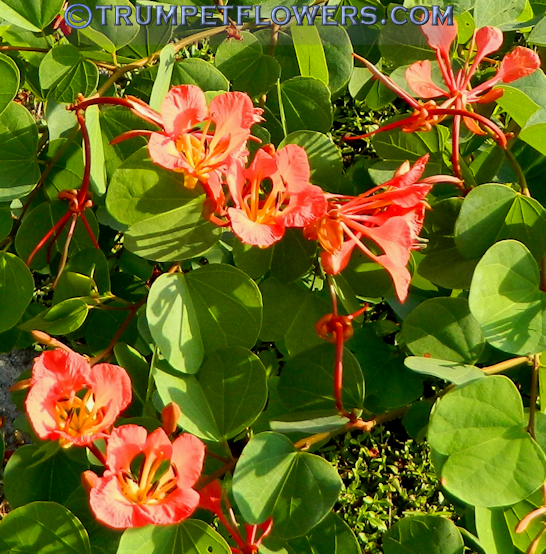
If you are collecting seed from bauhinia, it is best to wait until the seed pod is ripe, brown, and almost ready to pop open on it's own. I made the mistake of thinking Bauhinia tomentosa was ripe, only to open an immature (brown too) seedpod and found the small seeds still strongly attached, like an umbilical cord, to the spine of the pod. None germinated. Try covering the unripe pods with an Organza bag to stop the seeds from spilling, and then collect when you see the seeds have spilled from the seedpod and fallen inside the bag.
You can hurry up the germination of orchid tree seeds by using a set of nail clippers and very gently clipping one corner of the long top of one seed, just removing enough of the outer shell covering to expose the greenish white seed beneath. Then soak them in a shallow bowl of water overnight, enough to see them slightly swell. You can then place them on dampened paper towels, beside each other, and place in a plastic baggie under the sink or some other dark place. Check daily for germination. This is when you will see on one end, a little sprout. It can take anywhere from 3 days (super fresh seed) to 6 weeks. Some of this depends on the species too.
Now they are ready to plant in a moist, homemade seedling mix or one you buy, your choice. I have one year old red galpinii seed I soaked as mentioned above, and planted on September 12th. I will report back on the first few to germinate, as an example.
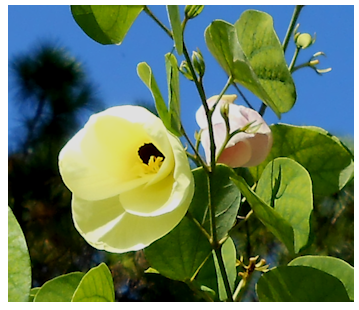 NOTE: The Bauhinia galpinii seeds just started peeking up. Today is September 24th, and the seeds were 1 year old. It has been raining for 5 days in a row, every afternoon, and I think that the rainwater itself has a lot to do with speeding up germination. I save it and use on all my seeds and seedlings as long as I have it available. So, that is a record up. Only 12 days from chipped and soaked seed until germination. Temperatures for the seeds have been between 74° at night, and up to 90° in daytime.
NOTE: The Bauhinia galpinii seeds just started peeking up. Today is September 24th, and the seeds were 1 year old. It has been raining for 5 days in a row, every afternoon, and I think that the rainwater itself has a lot to do with speeding up germination. I save it and use on all my seeds and seedlings as long as I have it available. So, that is a record up. Only 12 days from chipped and soaked seed until germination. Temperatures for the seeds have been between 74° at night, and up to 90° in daytime.
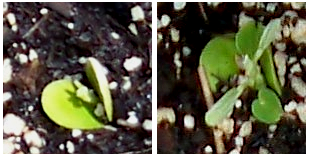 Another thing to note about planting bauhinia galpinii (and other species of bauhinia too) seeds is to let them lie very close to the soil surface, just barely dusting them with any cover of soil. Bauhinia seed will come through the soil with their seed coat leaves up on the stem, (the actual seed!) and use the foodsource inside as the stem continues to grow and the plant creates new leaves. They do eventually
Another thing to note about planting bauhinia galpinii (and other species of bauhinia too) seeds is to let them lie very close to the soil surface, just barely dusting them with any cover of soil. Bauhinia seed will come through the soil with their seed coat leaves up on the stem, (the actual seed!) and use the foodsource inside as the stem continues to grow and the plant creates new leaves. They do eventually
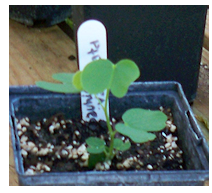 absorb them, but they turn green as they are kissed by the sun and need to be left intact. After they dissapear you can begin lightly fertilizing the young seedling. Notice in the photo that on day one of up, it already has the little 'tree' inside the two seed leaves? It is even more pronounced on day 2.
absorb them, but they turn green as they are kissed by the sun and need to be left intact. After they dissapear you can begin lightly fertilizing the young seedling. Notice in the photo that on day one of up, it already has the little 'tree' inside the two seed leaves? It is even more pronounced on day 2.
Like some other orchid trees, bauhinia galpinii also spits the ripe seeds, the pods suddenly flying open with a loud 'craaaaack' sound when it pops open and spreads the seeds over a 5 or 6 foot range. I have also read on some sites on the internet that bauhina galipinii do not readily set seed pods if in one of their more northern ranges, like the edges of zone 9. Not so, they do set seed here, I've seen the bushes with fat seed pods on them with my own eyes, as high north as edges of Orlando, Florida.
Bauhinia tomentosa (the yellow flowered bauhinia shown above) is easier to propagate from seed if they are still a bit green. You want to see the outside of the pod is a light brown, and run your fingers across the pod to make sure you feel the swollen bumps that are the seeds. I have tried to get them up from cracked open seed pods, but germination was slower, and some didn't come up at all. With the slightly green seeds, I get them up in about 2 to 3 weeks.
Here is a link to another page I wrote on getting bauhinia up from seed. This one is on Bauhinia Divaricata, an hard to find but exceptional species: Starting Bauhinia divaricata from seed.
Most bauhinia are evergreen, if in a tropical climate. They may drop their leaves for a month or so if it gets chilly, but they regrow quickly. Sometimes they will even flower during this time, filling the otherwise nude tree with hundreds of beautiful blooms.
Soils For Bauhinia
Soil for bauhinia can vary. Where I live, it is very sandy, with little organic material found naturally in the soil. When I plant out a sapling I have grown or purchased, I dig a very wide hole; about two and a half feet across by two and a half to 3 feet deep. I dump in a premade mixture of one third peat, one third good grade compost, and one third the soil from the digging. This way the young bauhinia has to only slowly adapt to the crummy soils we have. That is why if you have the same soil type as I do, it is important to fertilize the tree to help it keep going.
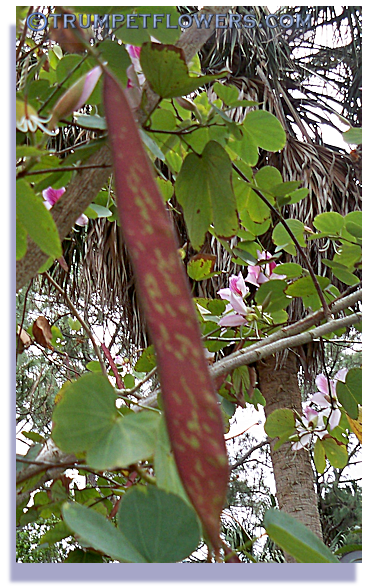 If your soil contains more clay, you might want to dig a little deeper hole, to help the young tree's taproot get down quicker. A rich, loamy forest type soil with plenty of organic material is the envy of all, and if you are lucky enough to have this soil type, your tree will flourish with very little extra added attention.
If your soil contains more clay, you might want to dig a little deeper hole, to help the young tree's taproot get down quicker. A rich, loamy forest type soil with plenty of organic material is the envy of all, and if you are lucky enough to have this soil type, your tree will flourish with very little extra added attention.
If in the ground, water the young tree deeply twice a week for the first year. This will keep it growing strongly. After the bauhinia's taproot hits your water table, you will not have to water it anymore. Where I live, the water table is only about 4 feet beneath the soil. It takes my trees about one and a half years for the taproot to find it.
There is a hardpan of clay in Southwest Florida. It can be found anywhere from 3 to 6 feet down, and when your shovel or post hole digger hits it, you will find it tough to break through, usually filled with chips of gray and rusty colored clay, and limestone. Breaking through this hardpan will help the bauhinia's taproot. You won't find it in all locations in your yard, but it is worth digging at least 5 feet down to be sure the place you are planting it out in is either free of the hardpan, or you have hit it and need to break through. It is a crust about 6 inches to a foot thick in my location.
If you don't break through the hardpan, the taproot will run into it and linger. It will still break through it, but it will take it longer to do so. The advantage is two-fold. Breaking the hardpan lets the tree grow faster. Breaking the hardpan also allows the taproot to find the water table faster, allowing you to be free of the watering routine!
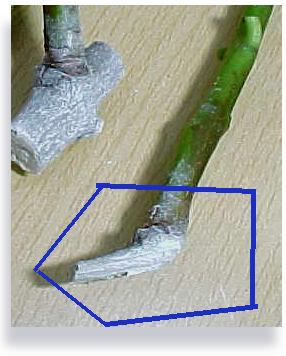 Bauhinia also do well in the south Florida landscape, and are great for those of you who have smaller lots. The tree will not overwhelm your neighbors, (or you) and it grows very fast. Fast enough that within 2 years the tree can reach between 6 and 1o feet if fed and watered properly.
Bauhinia also do well in the south Florida landscape, and are great for those of you who have smaller lots. The tree will not overwhelm your neighbors, (or you) and it grows very fast. Fast enough that within 2 years the tree can reach between 6 and 1o feet if fed and watered properly.
Train Bauhinia as a Patio Plant
Some species of bauhinia are bushlike. They can easily be trained to a main leader trunk and side branches with proper pruning. This is what makes such lovely patio plants. Not only do some stay small to medium, but look like large bonsais parked on your porch. Heel Cut (see above photo) the taproot about middle of planter if you are going to grow bauhinia in a container. It will sprout many strong side roots and still grow on strong. When doing this, make sure to use a liquid fertilizer on the tree for a month or so, to give the bauhinia extra nutrients and allow those side roots to form quickly, or you might lose the tree. And if you have rainwater, use it to water it at this time too. It helps stimulate the plant to grow strong new roots. If it wilts (and it probably will) at first, just keep it damp. This is a good time to prune the top growth too, so the newly forming root system will not have to support all that leaf growth.
Bauhinia Galpinii is an excellent choice for a lanai or enclosed patio. The deep red flowers are borne March through September, after only a year or so. Train to tree shape for a beautiful patio plant.
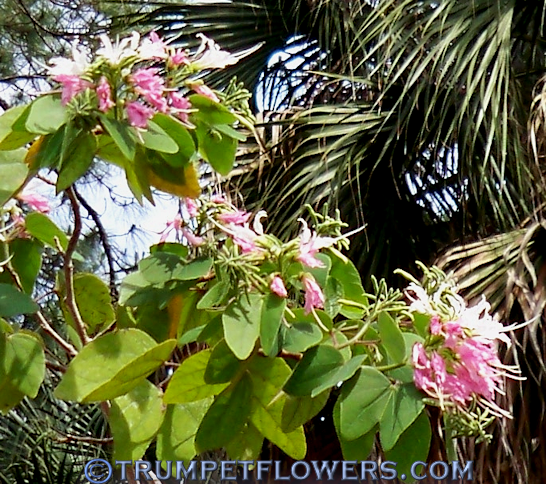
Bauhinia divaricata grows at a medium pace, does like fertilizer,
and eventually reaches a large size of 30 or more feet. The trunk is grayish, deeply grooved and supports lichens in many cases. The branches knarl and corkscrew in some cases, giving it a very unusual appearance. It will grow vine-like if it is not trained,
and will need some support the first few years of it's life in order to attain a standard shape. The tiny flowers show up in late winter to March, are mixed purple with white, whisp-like and fanning outwards. If you look closely, they are actually miniature flowers that look just as other bauhinia, in perfect orchid shape. The edges of the flowers are crinkled, adding interest to them. After flowers die, small bean pods follow, showing themselves as green in late May. They will turn brown and dry when ripe, only then can you pick the pods for removal of seeds. The leaves are deeply forked, and have the familiar appearance that ascertains all bauhinia, the cow hoof shape.
(You may find a deriviation of this paragraph over at Dave's Garden. I did not copy it, I wrote that/this entry myself)
There is also some mis∼information about bauhinia divaricata on the web. I have found many sites listing the plant as unable to withstand frost. Not so. Mine have withstood light frosts several times. People who write that stuff probably do not actually own the plants, but are quoting some other book or internet site. :(
Bauhinia Species Information List
- Bauhina acuminata Dwarf white orchid tree White flowers with a thinly veined green flag petal. 8 to 10 feet. Hardy to 25° after 1 yr. Photo
- Bauhinia blakeana or Hong Kong Orchid Tree Deep purple flowers. Grows 20 to 40 feet. Hardy to 25° after 1 yr
- Bauhinia bowkeri or Kei White Bauhinia Grows 15 to 20 ft. tall
- Bauhinia divaricata or Pata de Vaca Most unusual crinkled white & purple flower. Native to Americas. Hardy to 25° or so. Photo 1 Photo 2
- Bauhinia galpinii or Red Orchid Tree Train to tree, is bushlike. 10 to 20 feet. To 25° after 2 yrs. Photo
- Bauhinia monandra or Pink Orchid Tree Dwarfing type, Protect from frost. Great container plant.
- Bauhinia natalensis or Natal Bauhinia 10 to 15 ft, shrublike. Uncommon. White flowers. Hardy to 25°
- Bauhinia petersiana or Kalahari Bauhinia White crinkled blooms. Hardy to 25° after 3 yrs.
- Bauhinia purpurea or Fall Orchid Tree Spits seeds. Purple Flowers, midspring. 15 to 30 feet. Hardy to 25°
- Bauhinia racemosa or Mountain Ebony East Indian Holy tree. White flower with yellow flag petals. 10 to 15 feet.
- Bauhinia semla or White Orchid Tree Large white flowers w/red spotting. Only light frost hardy. Medium size
- Bauhinia tomentosa or Yellow Bell Orchid tree Fast growing. Hardy to 25° after 3 yrs. Photo
- Bauhinia variegata or Poor Man's Orchid, Mountain Ebony, Purple Orchid tree. Hardy to 25° after 6 months Photo ∼ Seed Pod Photo
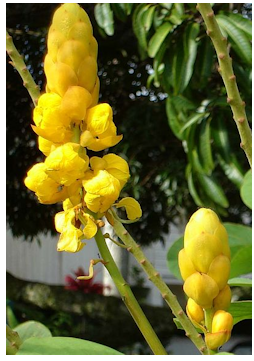
Pests of Bauhinia
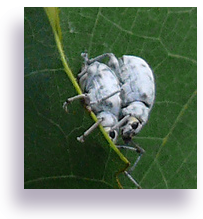 Bauhinia suffers from very few pests. One I have seen on the plant were small white moths that will roll a leaf or two inwards as a cocoon, and they cause no overall damage. One other, that is far worse, is the dreaded Pachnaeus litus weevil, also known as the Citrus weevil.. I sometimes find the silvery bluish whitish ones underneath the leaves. I have good fingernails, and simply pick them off and halve them, throwing them to the ground. They eat holes in the leaves, and discolor them through the spreading of disease, Get rid of them when you can. Because they are hard shelled, it really is better if you kill them by hand, rather than spraying.
Bauhinia suffers from very few pests. One I have seen on the plant were small white moths that will roll a leaf or two inwards as a cocoon, and they cause no overall damage. One other, that is far worse, is the dreaded Pachnaeus litus weevil, also known as the Citrus weevil.. I sometimes find the silvery bluish whitish ones underneath the leaves. I have good fingernails, and simply pick them off and halve them, throwing them to the ground. They eat holes in the leaves, and discolor them through the spreading of disease, Get rid of them when you can. Because they are hard shelled, it really is better if you kill them by hand, rather than spraying.
An excellent way to rid yourself of the weevils is to first lay down a white blanket or cloth, and wrap it all around the trunk of the tree. Make sure the spread is as far out as the canopy of leaves. Then shake the tree vigorously. Weevils natural defense is to fall to the ground when disturbed. This will have them fall right into the sheet or blanket. Quickly gather up the corners and do away with them by moving the now wrapped blanket away from all of your plants, and dunk the entire blanket in a large 5 or 10 gallon bucket pre-filled with soapy liquid. Leave the submerged sheet in overnight, and then shake the dead bugs loose. Dry the sheet for another use.
If your weevil problem is too intense and you need to use a chemical, try using Bayer Insect, Disease and Mite Control.
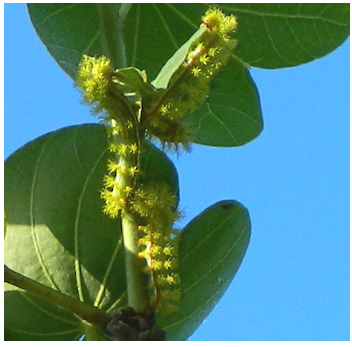 Io Moths will occassionally visit your bauhinia, although they prefer the taste of rose bushes and gardenia. I found these little caterpillars in late October, freshly hatched and munching away. If your bauhinia is too small to support them, pick them off using gloves. They have tiny spines that can be sharp, and release a slight irritant to your skin. I'm going to let them live, the adult moth is breathtakingly lovely! These nobby caterpillars are fluorescent green, with yellow and red striping along their sides. The heads are yellow or orange. Voracious, but beautiful. The adult moth photo (below) is accredited to Swampthings.blogspot.com She has a full size photo of the moths, along with other very interesting photos of insects and other wonders of nature.
Io Moths will occassionally visit your bauhinia, although they prefer the taste of rose bushes and gardenia. I found these little caterpillars in late October, freshly hatched and munching away. If your bauhinia is too small to support them, pick them off using gloves. They have tiny spines that can be sharp, and release a slight irritant to your skin. I'm going to let them live, the adult moth is breathtakingly lovely! These nobby caterpillars are fluorescent green, with yellow and red striping along their sides. The heads are yellow or orange. Voracious, but beautiful. The adult moth photo (below) is accredited to Swampthings.blogspot.com She has a full size photo of the moths, along with other very interesting photos of insects and other wonders of nature.
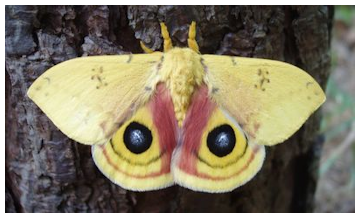 By the way, all bugs man has studied thus far have their breathing apparatus in their legs, an interesting fact that many don't know. So if their legs are submerged overnight, they will surely suffocate. The soap helps their exoskeletons to chip and break up, also rendering them dead.
By the way, all bugs man has studied thus far have their breathing apparatus in their legs, an interesting fact that many don't know. So if their legs are submerged overnight, they will surely suffocate. The soap helps their exoskeletons to chip and break up, also rendering them dead.
On a good note, spiders, bejeweled neon blue and green bees and other handsome insects often rest on the leaves of the tree, and are good for the environment and should not be harmed. I have never had to spray my bauhinias for any pests, as they are not in enough abundance to warrant this action.
Bauhinia Frost tolerance
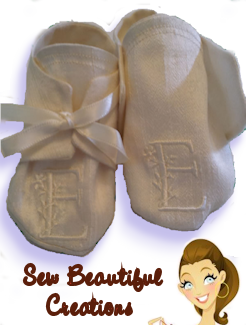 Most species of bauhinia are frost tolerant, my own accepting temperatures to about 25 or so degrees. They drop their leaves at those temperatures, but quickly grow them back. There are a few tender varieties, like Bauhinia monandra.
Most species of bauhinia are frost tolerant, my own accepting temperatures to about 25 or so degrees. They drop their leaves at those temperatures, but quickly grow them back. There are a few tender varieties, like Bauhinia monandra.
Bauhinia are native to Africa, China, India, and the Southern Americas. They are also found in Australia. They have been imported all over the the world. Their beautiful flowers and form, and fast growth rate, coupled with pest free keeping, make the orchid tree attractive in more ways than one.
If you have prolonged frost and a tender species of bauhinia, it may occur damage to the base and trunk. If you notice slight cracking, or worse, peeling, to the base of your tree, you might have frost damage. To prevent this in the future, wrap the base of the trunk in some type of cloth or blanket if you know frost threat is coming. You can also pile dried leaves from the previous fall around the base, or even wrap closely together Holiday lights around the trunk base until frost threat has passed.
Fertilize Bauhinia
Bauhinia should be fertilized with flowering tree spike(s) in early spring, summer and September. Fertilizer for rhododendron is also acceptable. If you want to keep it in a container, trim the rootball down by 6 inches or so, all the way around, and give it new soil. Trim the top greenery to match the size of the rootball. If you do this every year or so, the plant will remain small enough to reside on your patio or lanai.
Every bauhinia that I keep in SW Florida loves good fertilizing 4 times a year. You can use time released fertilizer that will last about 3 months. Give your trees a good dose of it for nice green leaves and many flowers. In mid winter, I give mine an extra dose, because I am expecting flowers from most varieties. If you live in a zone that has frost, do this in spring.
Prune Bauhinia in the landscape
Bauhinia also need to be pruned, and sharply at first. Most tend to become lanky if left to their own growth habits. Take off lower branches and cleanly cut the longer branches when the tree is at least one year old. Do this for 3 or 4 years to attain a canopy shape that is full and thick. If you do not prune it, it will most likely revert to it's natural growth habit, which can be sprawling branches that hang downwards.
Pruning bauhinia in late spring is best for southern growers for a couple of reasons. My trees mostly flower in winter, which will then bring the promise of seed pods come April or May. If you want seeds, then wait until after the pods ripen to prune them back. The plants grow back quickly, and within 3 or so months, if you've continued fertilizing them, you will not even be able to tell the trees have been pruned, except for the look of a tighter shaped tree. If seed pods are of no value to you, or you live further north and your plants bloom in spring instead of winter, go ahead and prune your bauhinia in the fall.
The Yellow Orchid Tree is properly known as Bauhina tormentosa. The flat green seed pods form soon after flowering. Flowers start out whitish yellow, then deepen to a creamy yellow, and finally turn whitish lavendar. Really beautiful. The leaves are a bit smaller than other bauhinias I have, but still retain the familiar cow hoof look that separates all bauhinas and makes them identifiable.
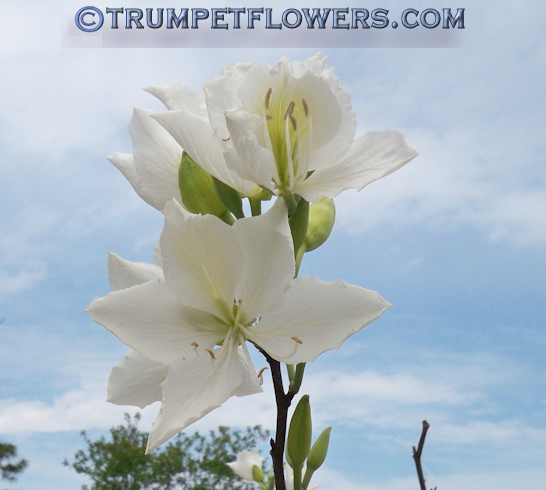
Bauhinia acuminata is one of my favorite Orchid trees. Also known as the Dwarf White Orchid tree, it often blooms a very heavy flush in December and January here, devoid of leaves. The leaves begin returning soon after, and by spring the entire tree is covered with seed pods and leaves. It sporadically blooms throughout the year, but I always see the best flushes in winter. The crinkled petals are beautiful, and the scent is like a delicious perfume. Of all the bauhinias I keep, I think it has the strongest scent. The flag petal is also white, with thin lime green stripes running vertically upwards, and then fanning outward. Incidentally, a December and January blooming tree brings ripened seed pods in early April where I live. (SW Florida)
Tags: bauhinia, bauhinia, grow bauhinia trees, orchid trees, start bauhinia from seed, start orchid trees from seed, prune bauhinia, fertilize bauhinia, bonsai bauhinia, patio container grow, cut taproot, bauhinia galpinii, red orchid tree, bauhinia variegata, bauhinia blakeana, bauhina purprea, bauhinia seeds, start bauhinia seeds, white bauhinia, orchid tree, hong kong orchid tree, bauhinia divaricata,
This entry was posted on September 12th, 2012 and is filed under Garden.